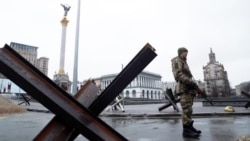On February 27, Major General Igor Konashenkov, press officer for Russia’s Defense Ministry, claimed the Russian military was only hitting Ukrainian military targets in its invasion of that country.
“On February 26, the Armed forces of the Russian Federation made another attack on Ukrainian military infrastructure facilities with long-range high-precision weapons, using air- and sea-based cruise missiles,” he said.
Russia’s TASS state news agency reported that Konashenkov denied Russian forces were attacking Ukrainian cities and villages, quoting him as saying they were "using their best efforts for protecting the life of civilians.”
That claim has proved false as evidence mounts of damaged civilian structures and rising civilian casualties – 2,000 such deaths according to the Ukraine government.
On March 1, Russian strikes hit civilian infrastructure in several Ukrainian cities, notably Kharkiv and the capital, Kyiv.
In Kharkiv, a missile struck the city’s Freedom Square near a civil administration building, killing at least six people. The sociology department building of Karazin National University in Kharkiv was also hit in one strike and caught fire. The Orthodox Assumption Cathedral also suffered damage in the attacks. Video also shows damage to residential buildings.
In Kyiv, the Holocaust Memorial at Babi Yar was also reportedly struck by a missile attack. Kyiv’s nearby TV tower was believed to have been the primary target of the attack, and the damage temporarily knocked Ukrainian TV off the air. Rockets also reportedly struck a nearby maternity ward.
Russia forces in Kharkiv have reportedly used cluster bombs, which spread deadly sub-munitions over a wide area, according to an Associated Press report citing Human Rights Watch as the source.
The sub-munitions, also called bomblets, are unguided and indiscriminate. They also pose a hazard if they fail to explode, effectively becoming landmines that can detonate when disturbed.
Shelling and missile attacks have also intensified near the port cities of Odesa and Mariupol, where Ukrainian forces are surrounded on two sides. On March 1, Russian artillery attacks cut off electricity in Mariupol.
The United Nation’s Human Rights Office says it had verified 136 civilian deaths resulting from Russia’s renewed invasion of Ukraine, although other estimates are much higher. On March 2, however, Ukraine’s emergency service said 2,000 civilians have been killed thus far in the Russian assault, which began February 24.
On March 2, Konashenkov again repeated his claim about precision weapons.
“As a result of the strike by Russian high-precision weapons, the destruction of residential buildings in Kyiv was not allowed,” he said.
But the facts on the ground say otherwise. Not only are Russia’s “precision” weapons not as precise as claimed, but as alluded to above there is evidence that Russia is striking cities with wide-area weapons such as cluster bombs and unguided rockets.
Even more worrying are allegations that Russia might use rockets with thermobaric warheads. These extremely destructive rockets are launched by the Russian-made TOS-1 launch vehicle, many of which were spotted moving toward the Ukrainian border prior to the offensive. At least on TOS-1 system was recently captured by Ukrainian forces.






